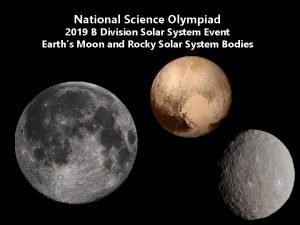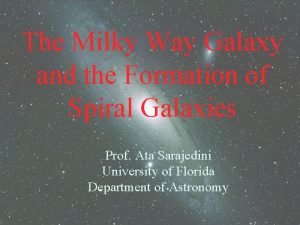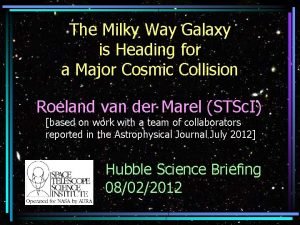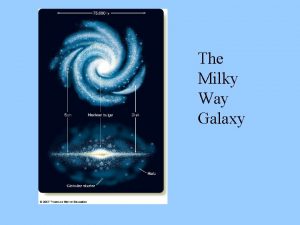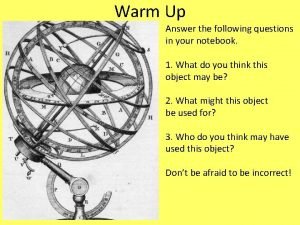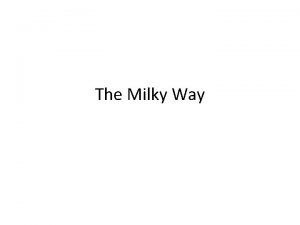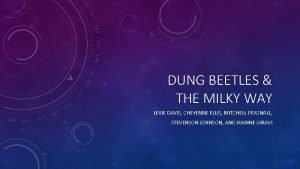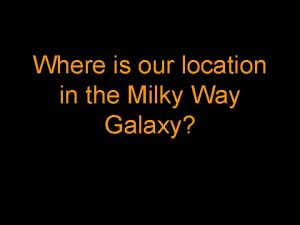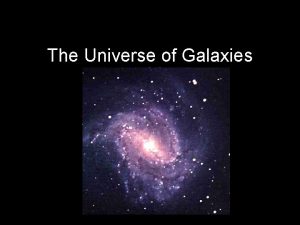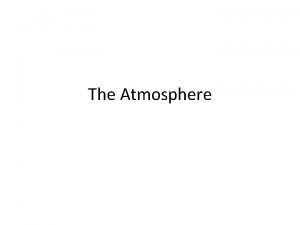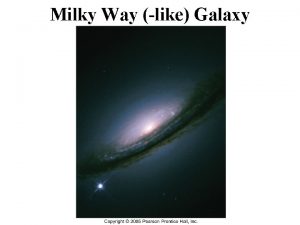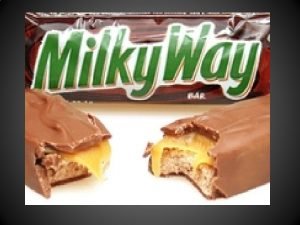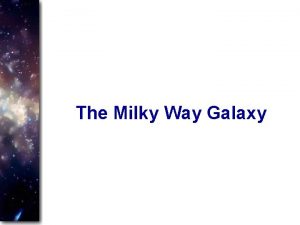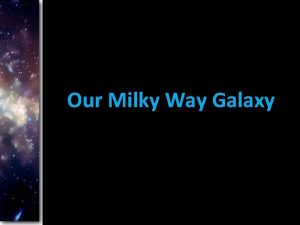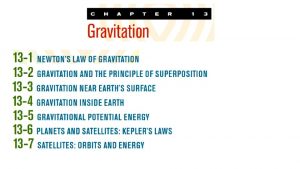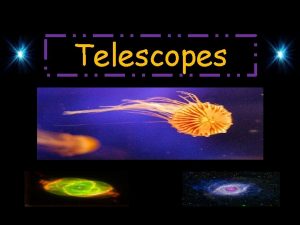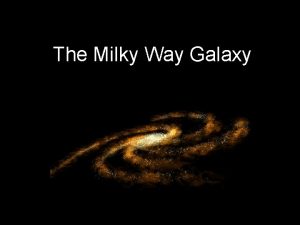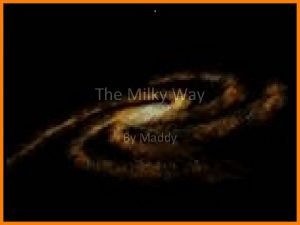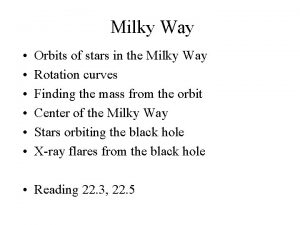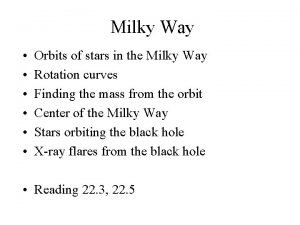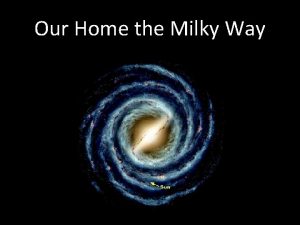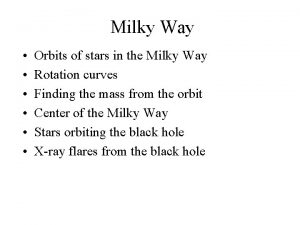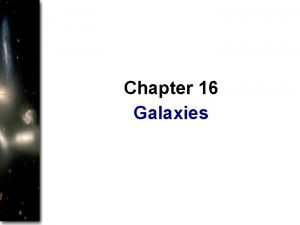The Milky Way Galaxy Contains more than 100






























- Slides: 30



The Milky Way Galaxy • Contains more than 100 billion stars • Is one of the two largest among 40 galaxies in the Local Group • Our Solar System is located a little more than half way from the galactic center to the edge of the galactic disk. • Only one of roughly 100 billion galaxies in the Observable Universe.


Galaxies • Definition: a system that contains millions or more stars. • Galaxy clusters: groups of galaxies with more than a few dozen members • Supercluster: galaxies and galaxy clusters tightly packed together. • Classified using a diagram called “Hubble’s Tuning Fork”


Our Cosmic Address 1. 2. 3. 4. 5. 6. Earth (4. 5 billion years old) Solar System (4. 6 billion years old) Milky Way Galaxy (13. 2 billion years old) Local Group Virgo Supercluster Observable Universe (13. 8 billion years old)




Milky Way Galaxy Structure • Known to look like flat pancake with a bulge in the center. • Named a Spiral Galaxy because of its spiral arms. • Approximately 23, 000 light years away from the nuclear bulge.





Parts of the Milky Way Galaxy • Nuclear Bulge: sphere of stars and other material at the heart of our galaxy. – about 4000 parsecs across (about a fifth of the total spread of the spiral arms of the galaxy. ) – The very center of our galaxy in a super-massive black hole. • 3 -4 million times as massive as the sun. • Appears to be powering a bright source of radio emmision known as Sagittarius A*.

Parts of the Milky Way Galaxy (cont. ) • Disk: Flat, rotating region of stars, dust and gas called interstellar medium around the Nuclear Bulge. – Can obstruct view for observations towards the Nuclear bulge. – Approximately 1, 000 light years in thickness and 100, 000 light years across

Parts of the Milky Way Galaxy (cont. ) • Spiral Arms: well defined bands in the disk because of brilliantly bright stars. • Halo: spherical in shape and contains little gas, dust, or star formation. • Globular clusters: a large compact spherical star cluster, typically of old stars in the outer regions of a galaxy.

Formation of Galaxies • A Protogalactic cloud contains Hydrogen and Helium. • Halo stars begin to form as the protogalactic cloud starts to collapse. • Conservation of angular momentum ensures the remaining gas flattens into a disk. • Billions of years later, the star-gas-star cycle supports ongoing star formation within the disk. The lack of gas in the halo prevents star formation outside the disk. http: //scienceforkids. kidipede. com/physics/space/momentum. htm


Facts about Galaxies and the Universe • Galaxies move apart • Expansion began about 13. 8 billion years ago (the Big Bang) – This is called cosmological redshift. – Proven by observing a faint glow of radiation that is a remnant of heat from the Big Bang. – Early Universe = hotter and denser – Today’s Universe = cooler and less dens because of expansion.

Facts about Galaxies • If you look at a galaxy that is 7 billion light years away you are seeing that galaxy as it appeared 7 billion years ago. • The number of stars in the observable universe is equal to the number of grains of dry sand on all beaches on Earth. • Large Magellanic Cloud and Small Magellanic Cloud orbit the Milky Way at 150, 000 light years and 200, 000 light years.

http: //www. universetoday. com/22828/milky-way-collision/

Nearby Galaxies • Andromeda Galaxy is comparable in size, though slightly larger. • Small galaxies (Sagittarius and Canis Major Dwarf Galaxies) are colliding with us right now! – These small collisions cause ripples in our galaxy and create new stars at points of collision.



Edwin Hubble (1889 -1953) • Studied stars and galaxies outside the Milky Way galaxy. • Designed a period-luminosity relation • Proved that Andromeda is much too far away to be part of Milky Way. • Known for Hubble Law • The more distant the galaxy, the faster its moving away = greater redshift • Galaxies are moving apart in our expanding universe.



 Lirik lagu more more more we praise you
Lirik lagu more more more we praise you More more more i want more more more more we praise you
More more more i want more more more more we praise you Galaxys
Galaxys Science olympiad solar system
Science olympiad solar system Milky way galaxy
Milky way galaxy Milky way galaxy sketch
Milky way galaxy sketch Most galaxies in the inner region of a large cluster are
Most galaxies in the inner region of a large cluster are 100 100 100 100 100
100 100 100 100 100 Milky way description
Milky way description Where is the solar system located in the milky way
Where is the solar system located in the milky way Democritus milky way
Democritus milky way Dung beetle milky way
Dung beetle milky way What is the name
What is the name The milky way
The milky way My fonterra milky way
My fonterra milky way Percents greater than 100 and less than 1
Percents greater than 100 and less than 1 More er than
More er than Half life more than 2 less than 4
Half life more than 2 less than 4 Greater than god and more evil
Greater than god and more evil Lime water milky
Lime water milky Zjezd
Zjezd Milky ribbon worm
Milky ribbon worm Milky appearance of plasma
Milky appearance of plasma A building that contains one or more telescopes
A building that contains one or more telescopes 30 sayısının yüzde 20 eksiği kaçtır
30 sayısının yüzde 20 eksiği kaçtır 200+200+100+100
200+200+100+100 Box plots gcse
Box plots gcse Malloc lab 100/100
Malloc lab 100/100 1453-1337
1453-1337 100+100=200
100+100=200 100 iops/gb and 100,000 iops per volume oci
100 iops/gb and 100,000 iops per volume oci



